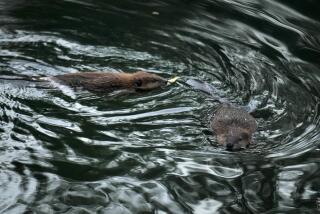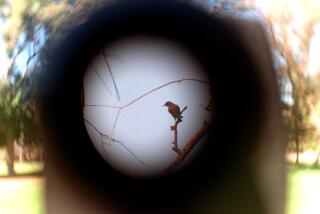To enter the world of biology professor...
To enter the world of biology professor Bernd Heinrich is to recapture a place and time past, when watching the wildlife on the bog of your Vermont property might take up a significant portion of the day, when paying close attention to life as it unfolds each spring might be one of life’s highlights. It is a respite, a delightful sanctuary in this world that seems to grow more chaotic and noisy by the day. Crossing the threshold into “The Geese of Beaver Bog,” we are transported into this realm of keeping tabs on the geese that visit each year, tracking the changing seasons, gauging the migration and mating of the bog’s resident and visiting wildlife, all the while reveling in the natural world.
The book grew out of an informal geese-observation project Heinrich (“Mind of the Raven” and other science-themed narratives) initiated one year when a neighboring farmer who kept domestic geese placed two wild Canada goose eggs among his geese’s own. The incubation paid off, and two wild geese were hatched. Heinrich’s 2-year-old son, Eliot, adopted the goslings. One of the pair, named Peep, survived to adulthood and, by fall, had left the domesticated lodgings to join her wild friends.
Two years later, Heinrich is astonished when a pair of wild geese stops by his house for what seems to be a visit. “What was the pair doing here?” he wonders. “Why did they land? There was not yet a sprig of green grass for them to feed on.” He fights his own wishful thinking that Peep may have come home. “She had been gone for so long -- two winters -- that I could not indulge in such fantasies.” But it is Peep -- he identifies her by a distinctive mark on her eyelid -- and she seems to remember Heinrich and wants to make contact with him.
Thus he begins spending countless happy hours watching Peep and Pop, the mate she’s brought with her, as they search for suitable nesting spots in the bog, fly up to the house regularly for visits, scare away other geese that might be trying to usurp their territory and take steps toward hatching their own young. Thanks to nefarious actions on the part of mystery characters -- Heinrich suspects another geese pair nesting nearby -- all but one of Peep’s eggs is destroyed and the gosling she hatches is found dead the next day. In the aftermath, Peep and Pop leave the nesting bog for the molting grounds up north, leaving Heinrich unsure if he’ll ever see Peep again.
But Pop returns the following spring only to hook up with another goose, whom Heinrich names Jane. A few days later Peep shows up and finds her mate’s been taken. Are geese monogamous? he wonders. Geese and other waterfowl return to nest year after year at or near the same place where they have nested before. “If both members of a pair return to the same ‘house,’ then that behavior alone would make them functionally monogamous. Had Peep returned to the bog several days earlier, and Jane later, then Peep and Pop might still be a pair.”
Over the following years, Heinrich tracks all geese that come to Beaver Bog and notes their at times confusing interactions with one another: During nesting season, for example, they’re vicious about keeping other geese away, and as the attack on Peep’s eggs showed, they can be downright cutthroat in destroying others’ chances at reproduction. But once the young are hatched, they give up their territory quickly and disappear from the bog altogether. Once Heinrich figures out where they’ve gone -- they’ve migrated overland with the goslings a few miles to Sunset Lane pond, where it’s safer for the young and food is more abundant -- he’s amazed to find the previously antagonistic geese establishing interfamily communities among themselves and easily adopting the young of their neighbor. This is just one of the many mysteries Heinrich sleuths.
The text is accompanied by color photographs and Heinrich’s detailed pencil sketches of the geese, their face masks and identifying characteristics, but it is his lyric writing and attentive observations that make the goose world come alive. Heinrich takes the time to consider carefully and deeply the wonders of the natural world and extrapolate from what he sees. “I can’t see the wind any more than I can see genius without works, but I see its course as it charges and makes swirls on the water. The animals and the bog, too, are like random ripples that conform to or combine into a larger picture, if one can only detect it.”
Reading “Beaver Bog” and luxuriating in the time it takes to discern this larger picture is pure joy and the next best thing to taking a deliciously long and tranquil bog outing of one’s own.
More to Read
Sign up for The Wild
We’ll help you find the best places to hike, bike and run, as well as the perfect silent spots for meditation and yoga.
You may occasionally receive promotional content from the Los Angeles Times.






